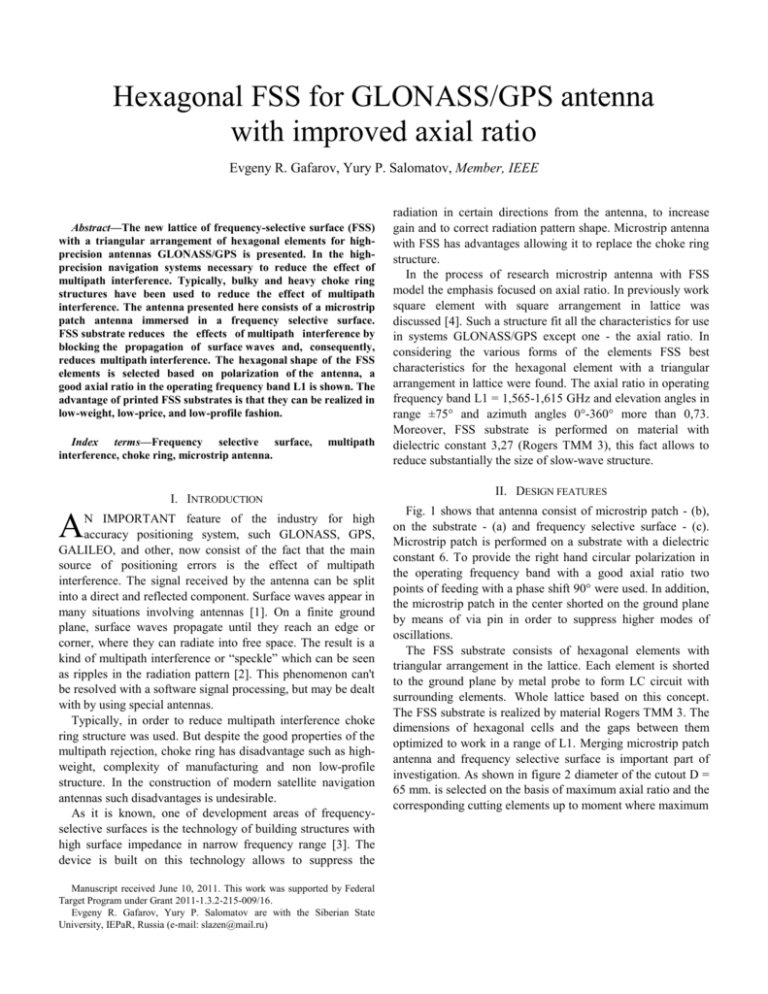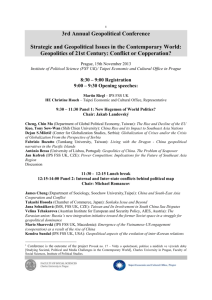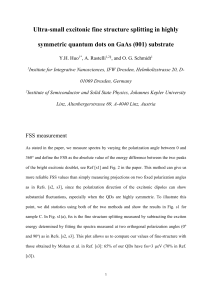iii. simulation results
advertisement

Hexagonal FSS for GLONASS/GPS antenna with improved axial ratio Evgeny R. Gafarov, Yury P. Salomatov, Member, IEEE Abstract—The new lattice of frequency-selective surface (FSS) with a triangular arrangement of hexagonal elements for highprecision antennas GLONASS/GPS is presented. In the highprecision navigation systems necessary to reduce the effect of multipath interference. Typically, bulky and heavy choke ring structures have been used to reduce the effect of multipath interference. The antenna presented here consists of a microstrip patch antenna immersed in a frequency selective surface. FSS substrate reduces the effects of multipath interference by blocking the propagation of surface waves and, consequently, reduces multipath interference. The hexagonal shape of the FSS elements is selected based on polarization of the antenna, a good axial ratio in the operating frequency band L1 is shown. The advantage of printed FSS substrates is that they can be realized in low-weight, low-price, and low-profile fashion. Index terms—Frequency selective surface, interference, choke ring, microstrip antenna. multipath I. INTRODUCTION A N IMPORTANT feature of the industry for high accuracy positioning system, such GLONASS, GPS, GALILEO, and other, now consist of the fact that the main source of positioning errors is the effect of multipath interference. The signal received by the antenna can be split into a direct and reflected component. Surface waves appear in many situations involving antennas [1]. On a finite ground plane, surface waves propagate until they reach an edge or corner, where they can radiate into free space. The result is a kind of multipath interference or “speckle” which can be seen as ripples in the radiation pattern [2]. This phenomenon can't be resolved with a software signal processing, but may be dealt with by using special antennas. Typically, in order to reduce multipath interference choke ring structure was used. But despite the good properties of the multipath rejection, choke ring has disadvantage such as highweight, complexity of manufacturing and non low-profile structure. In the construction of modern satellite navigation antennas such disadvantages is undesirable. As it is known, one of development areas of frequencyselective surfaces is the technology of building structures with high surface impedance in narrow frequency range [3]. The device is built on this technology allows to suppress the Manuscript received June 10, 2011. This work was supported by Federal Target Program under Grant 2011-1.3.2-215-009/16. Evgeny R. Gafarov, Yury P. Salomatov are with the Siberian State University, IEPaR, Russia (e-mail: slazen@mail.ru) radiation in certain directions from the antenna, to increase gain and to correct radiation pattern shape. Microstrip antenna with FSS has advantages allowing it to replace the choke ring structure. In the process of research microstrip antenna with FSS model the emphasis focused on axial ratio. In previously work square element with square arrangement in lattice was discussed [4]. Such a structure fit all the characteristics for use in systems GLONASS/GPS except one - the axial ratio. In considering the various forms of the elements FSS best characteristics for the hexagonal element with a triangular arrangement in lattice were found. The axial ratio in operating frequency band L1 = 1,565-1,615 GHz and elevation angles in range ±75° and azimuth angles 0°-360° more than 0,73. Moreover, FSS substrate is performed on material with dielectric constant 3,27 (Rogers TMM 3), this fact allows to reduce substantially the size of slow-wave structure. II. DESIGN FEATURES Fig. 1 shows that antenna consist of microstrip patch - (b), on the substrate - (a) and frequency selective surface - (c). Microstrip patch is performed on a substrate with a dielectric constant 6. To provide the right hand circular polarization in the operating frequency band with a good axial ratio two points of feeding with a phase shift 90° were used. In addition, the microstrip patch in the center shorted on the ground plane by means of via pin in order to suppress higher modes of oscillations. The FSS substrate consists of hexagonal elements with triangular arrangement in the lattice. Each element is shorted to the ground plane by metal probe to form LC circuit with surrounding elements. Whole lattice based on this concept. The FSS substrate is realized by material Rogers TMM 3. The dimensions of hexagonal cells and the gaps between them optimized to work in a range of L1. Merging microstrip patch antenna and frequency selective surface is important part of investigation. As shown in figure 2 diameter of the cutout D = 65 mm. is selected on the basis of maximum axial ratio and the corresponding cutting elements up to moment where maximum 10 a 0 b Gain (dB) c -10 -20 R -30 -40 -180 -120 -60 0 Theta (°) 60 120 180 RHCP Cross-polarisation Fig. 3. Gain patterns. Right hand circular polarization (RHCP) – solid and cross-polarization – dashed line for the 4 cuts: phi = 0°; 45°; 90°; 135°. Frequency 1,575 GHz. D 1,0 H 0,9 Axial ratio Fig. 1. Design of frequency selective surface with immersed patch antenna. c 0,8 0,7 0,6 0,5 1,54 a b 1,56 1,58 1,60 1,62 1,64 Frequency (GHz) Curves: Phi = 0°, 45°, 90°, 135°; Theta = -75°, -40°, 0°, 40°, 70° envelope line Fig. 4. Simulated axial ratio versus frequency. the gap along the element, describing the optimal performance of the element FSS and compactness, weight and size. III. SIMULATION RESULTS Fig. 2. Zoomed fragment of patch antenna with FSS. length of the gap between the elements is saved. All adjacent elements are joined with a metal ring and shorted on to the ground plane by means of metal pins. Such an artificial metal wall divides the area of immersed patch and the FSS substrate in terms of the minimum reflection coefficient. Furthermore, metal pins are located along cutting radius to provide uniform circular current along whole lattice. This fact results in improvement the axial ratio. The maximum overall size of the lattice is R = 279 mm. Height of substrate for patch and FSS equals H = 6 mm. Trimming the external shape FSS is based on the fact to save the maximum length of In order to assess the multipath rejection properties of the FSS substrate and axial ratio, the side lobe level (or radiation in backside direction for multipath rejection) of the antenna has been evaluated for different frequencies and different phi cuts. Figure 3 shows the radiation pattern of patch antenna with FSS to the four corners of the azimuth at a frequency of 1,575 GHz for the right-hand circular and cross – polarization. Gain in operating frequency band better than 8 dB, the level of cross-polarization less than -23 dB. Due to the FSS lattice the radiation level in backside direction from antenna is not more than -21 dB in different phi - cuts. This is characterized by a very good multipath rejection of antenna system. Figure 4 shows the dependence of axial ratio versus frequency for each partition plane for azimuth angles phi = 0°, 45°, 90°, 135°, five values elevation angles theta = ±75°, ±40°, 0° were investigated. The envelope line (dashed) shows the minimum values for which the axial ratio for investigated angles in operating frequency band of at least 0,73. For comparison, axial ratio for square lattice FSS no more than 0,5 in L1 band [4]. IV. CONCLUSION Investigation has shown that the hexagonal FSS can improve axial ratio of microstrip antenna compared with the square FSS. Without decreasing the multipath rejection (side lobe level -21 dB as well as for square lattice) microstrip antenna with hexagonal FSS showed a good axial ratio better than 0,73 (-2,7 dB) in the operating frequency band and wide range of azimuth and elevation angles. Further improvement of axial ratio is only possible with the use the multilayer structures of complex shape. Weight and height of choke ring up to 10 times greater than FSS lattice. It can be concluded that combining FSS technology with antennas can result in low-weight, low-cost, and low-profile alternatives as compared to current solutions. REFERENCES [1] [2] [3] [4] Lorena I. Basilio. A Comparative Study of a New GPS ReducedSurface-Wave Antenna // IEEE Antennas and wireless propagation letters, 2005. Vol. 4. P. 233–236. M. Dinius, GPS Antenna Multipath Rejection Performance Massachsetts Institute of Technol., Lincoln Lab., Cambridge, MA, Rep. ATC-238, Aug. 1995, vol. 70. Dan Sievenpiper, High-Impedance Electromagnetic Surfaces with a Forbidden Frequency Band, Member IEEE, Lijun Zhang, Romulo F. Jimenes Broas, Nicholas G. Alexopolus, Fellow IEEE // Transaction on microwave theory and techniques. Vol. 47, no. 11, November 1999. E. R. Gafarov, Antenna GLONASS/GPS with frequency selective surface // Izv, universities. Physics. Monthy scientific journal, vol 53, sep. Tomsk, Tomsk state university, 2010 - P. 60-61.



